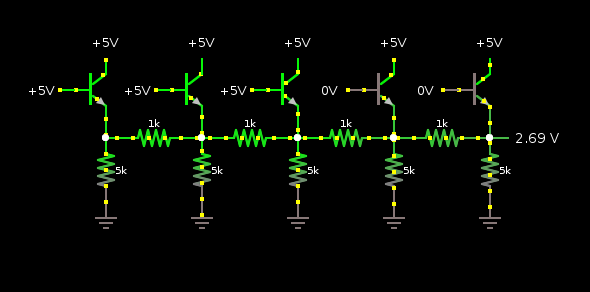Tonight I finished the hardware for the HiHat pedal. The enclosure is a narrow wooden box with one side missing, which is attached to a base that a bass drum pedal can mount to. Instead of a beater there is a baffle attached to the drum pedal, which moves down. As it moves it blocks the light from reaching a series of IR phototransistors.
The transistors are arranged something like this (instead of the voltage on the base of the transistors, it is the light from the IR diodes across from each one). So, in this diagram, the baffle is partway down and blocking the first two lights. The output is attached where the 2.69V measurement is read in the simulation.

There is a separate photo transistor which senses when the pedal is completely closed. This will be used as the 'tightly closed' switch. (Technically I could have done it all with a single input... I used separate ones for the analog and digital portions because I was following the implementation of my Drum Master 1.0 set, and I figured I would just use the same design here since it was verified to work. After the board was made and I started work on the hihat pedal I realized that having two channels was somewhat redundant. Oh well, no harm done, I still have two unused inputs that I have not even bothered to make pads for... the 9 pads I have already are more than enough for now.)
Pictures of the actual enclosure will be forthcoming in a later log entry.
Next step is to write the software which interprets the input from the pedal.
Cheers
Edit: It seems there is only one problem with this pedal: The 6 IR LEDs (each with a 200 ohm resistor in series with them) seem to bump my total power consumption just a bit higher than my 3.3v 250mA regulator can reliably source, and I am getting intermittent brownouts. No big deal, I just changed the LEDs to run off of the 5v supply (which is only running the display and thus has plenty of current to spare). Oh well... live and learn. Next time I will use a beefier regulator if I am unsure of the current consumption.
 The Big One
The Big One
Discussions
Become a Hackaday.io Member
Create an account to leave a comment. Already have an account? Log In.